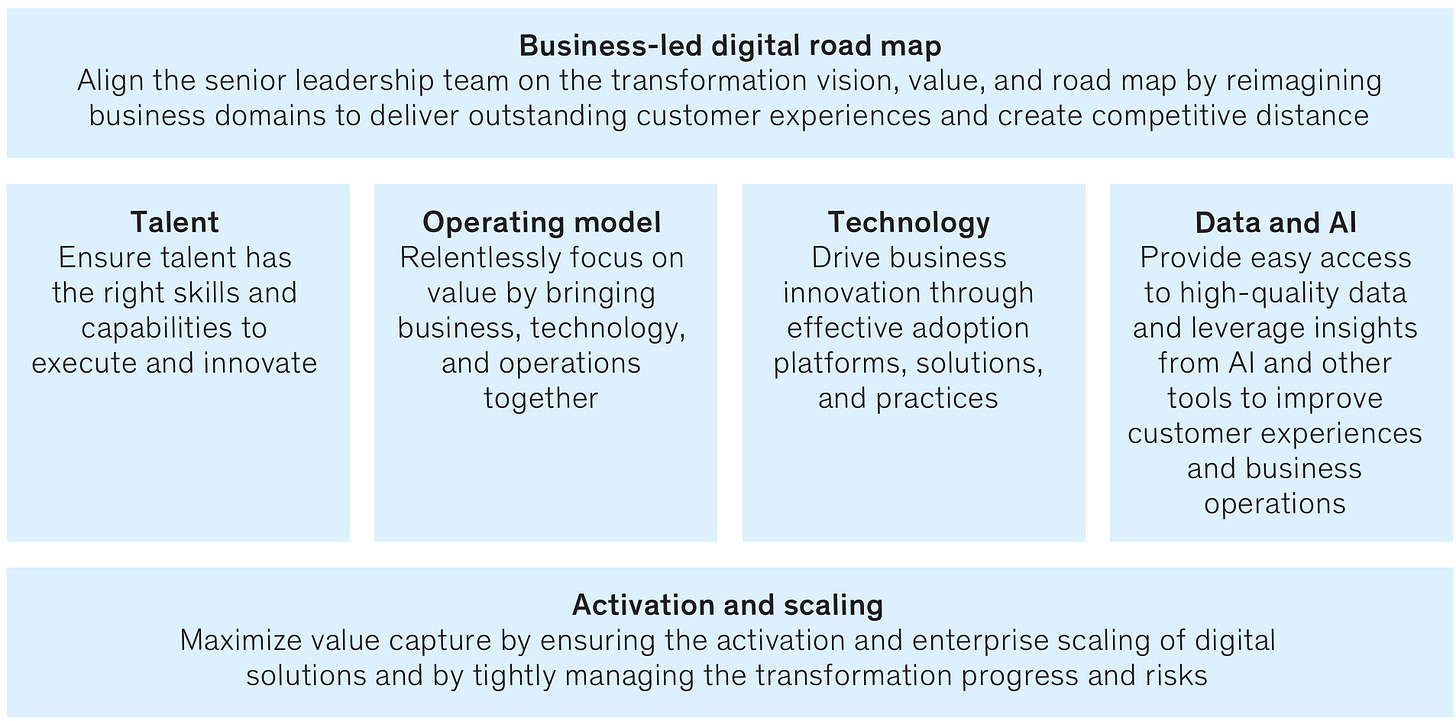Superagency and Agentic Mesh Architecture Approach for implementing the new enterprise.
Reid Hoffman's new book on Superagency, gives a vision of the future. One important way this will be implemented is using and Agentic Mesh architecture. We explore how to implement it.
In "Superagency," Reid Hoffman presents an optimistic vision of AI as a tool for enhancing human capabilities and creating a better future. He argues that AI can assist in various fields like education and research, while also acknowledging potential challenges. Ultimately, Hoffman encourages readers to embrace AI's opportunities and shape a future where human ingenuity and AI work together to achieve extraordinary outcomes.
The question is how do we actually implement this new Superagency within and enterprise. The challenge is large one:
Fundamentally challenging the future of the firm
Devising a new operating model on which the firm will work, with the melding between people and AI
Transitioning to this new model - a painful and expensive undertaking for any enterprises of size.
An emerging idea with Agents has now gaining traction this year. The idea is Agents is wonderful, but the implementation of them requires significant work. Both from a technology build perspective - to implement a new architecture and platform, as well as a how a firm will transform to be able to use this technology. The Agentic Mesh (as defined by
is a comprehensive one, and one that could help drive a new architecture approach, and how this could be the foundations to deliver the technology side of the changeTwo ideas merged
The convergence of Superagency and the Agentic Mesh represents a significant shift in how we approach work, driven by the rapid advancement of artificial intelligence (AI). Superagency describes a state where humans, augmented by AI, achieve unprecedented levels of productivity and creativity. The Agentic Mesh is the technological infrastructure that supports this transformation by providing a flexible and scalable framework for deploying and managing AI tools. These two concepts are intertwined, with the Agentic Mesh providing the necessary foundation for Superagency to flourish.
Superagency: Amplifying Human Potential Through AI
Superagency is not merely about automating tasks; it is about fundamentally changing how humans and machines collaborate. It is a state where AI acts as a 'supertool', augmenting human capabilities across a range of cognitive functions . Key aspects of this include:
Cognitive Automation: AI is increasingly capable of automating cognitive functions like planning, problem-solving, and decision-making. This allows human workers to focus on strategic and creative activities that require uniquely human skills. AI agents can also autonomously complete complex tasks.
Democratisation of Knowledge: AI tools democratise access to knowledge, lowering skill barriers and enabling more people to become experts in their fields. This creates a more inclusive and empowered workforce.
Human-AI Collaboration: Superagency emphasizes the collaboration between humans and AI, leveraging the strengths of both. This results in more efficient and innovative problem-solving, with AI acting as a thought partner rather than just a tool.
Agentic AI: The Autonomous Workforce in Action
A crucial aspect of the implementation of Superagency is Agentic AI, where AI models and tools can act autonomously to complete complex tasks, with or without human oversight. This contrasts with traditional AI systems that often require constant human guidance and oversight, as well as Governance and compliance across the enterprise:
Autonomous Agents: AI agents can independently interact with customers and other systems, make decisions, and execute plans without direct human intervention. These agents can handle tasks such as processing payments and managing logistics, simulating complex business processes autonomously.
Multimodal Processing: AI systems are increasingly capable of processing multiple data types like text, audio, and video. This allows for richer, more dynamic interactions and a broader range of applications.
Advanced Reasoning: AI models are demonstrating advanced reasoning capabilities, going beyond simple data synthesis and information retrieval to act as a human-like thought partner. For example, the ReAct framework enables AI agents to reason and act using tools.
The Agentic Mesh: A Scalable Infrastructure for AI
To successfully deploy agentic AI and realise the full benefits of Superagency, organisations need a robust and adaptable infrastructure, the Agentic Mesh. This architecture provides:
Unified Abstraction Layer: A single point of access for a variety of AI services and resources, simplifying the complexity of AI adoption.
Federated Services: Centralized control and analysis of AI applications across the entire organisation, enabling consistency and scalability.
Centralized Catalogue: A single, easy to navigate repository for finding and managing AI assets such as models, tools, and agents.
Modular Development: Facilitates a more flexible and efficient approach to building AI applications [10]. Developers can combine elements such as LLMs, agents, and tools to create custom solutions.
Simplified Management: Reduces the complexity of managing AI assets, improving security, safety, and overall performance.
Bridging POC to Production: Helps organisations move AI solutions from the proof-of-concept phase to real-world production, ensuring sustained value [14].
Practical Insights and Challenges in Adopting AI
Research indicates that organisations are at various stages of AI adoption, facing both opportunities and challenges. Key insights include:
Employee Readiness: Many employees are already using AI, but there's a need for more training and support and a cultural change to an approach to work.
A significant portion of employees believe that AI will substantially change their work within two years, but how this change will actually happen is still being invented.
Employees rank training as a top factor for successful AI adoption. Not just training but a different way of thinking and working with and Agents and other tools to successfully and more efficiently delivering the required outcomes.
Leadership Imperative: Leaders need to drive AI adoption, but some feel their organisations are moving too slowly [19]. A significant percentage of leaders acknowledge their organisations are developing AI tools too slowly [19].
Balancing Speed and Safety: It is crucial to balance AI development speed with safety measures to ensure security, privacy and accuracy, addressing concerns such as data security, biased output, and potential misuse [20]. Employees tend to trust their employers more than other institutions to deploy AI responsibly [20].
Strategic Investment: Companies need strategic roadmaps for AI investment with a focus on measurable return on investment (ROI). Despite the excitement surrounding AI, many organisations have not yet seen a significant return on investment [21].
A significant percentage of companies plan to increase investments in AI, and we’re seeing that this year, budgets have opened up and outcomes are being more clearly defined.
Transformative Goals: Businesses should focus on using AI to transform entire industries and look at how their enterprise fits into the value chain of their industry, rather than just implementing small scale localised solutions.
Organisational Change: Leaders must address operational challenges such as budget flexibility, workforce planning, leadership alignment, and supply chain dependencies.
Operating Model Shifts for the AI Era
To fully harness AI, companies must adapt their operating models. This includes:
Increase Investments: Shift from basic experimentation to investments that deliver quantifiable results.
Develop Strategic Roadmaps: Create thorough roadmaps to identify valuable use cases and achieve a measurable ROI.
Agile Budgeting: Adopt a flexible approach to budgets, given the rapid pace of technological changes.
Federated Governance: Allow for team autonomy, while maintaining centralised oversight.
Use Benchmarking: Adopt standardised benchmarks to assess AI performance, safety, and ethical considerations.
Upskilling and Hiring: Recruit AI talent while also upskilling existing employees.
Human-Centric Practices: Incorporate diverse perspectives and implement human-centric design principles.
Mckinsey provides a nice diagram for a summary how you could structure the transformation.
The Path Forward: Embracing the AI-Driven Future
The fusion of Superagency and the Agentic Mesh signals a transformative moment in the evolution of work. Companies that embrace these new approaches will be best placed to innovate, compete, and succeed in an AI-driven world. This requires not only technological innovation but also a commitment to a new way of working, centred on collaboration, human empowerment, and ethical practices. Further it needs a rethink of the business model an operating model of the firm.
By focusing on these aspects, organisations can create workplaces where humans and AI work together to unlock a new era of productivity, creativity and progress, marking the start of an exciting future for both humans and technology.
References
Subscribe for more posts from Fintricity.






